Church Furnishings and Windows, Part 2
South Side (right, front to rear)

1. The St. Patrick window (photo at left) honors the Irish origins of the founders of the parish. St. Patrick (c. 389-c. 461), the patron saint of Ireland, is depicted here dressed as a bishop in red vestments, holding in his left hand the crosier of a bishop. The shamrock which he holds in his right hand identifies him as St. Patrick. The single large figure is set into a softly defined landscape background. A hyacinth grows at his feet, a symbol of Christian prudence. The feast day of St. Patrick is March 17.
The upper part of the lancet has a rounded architectural motif with a draped Latin cross featuring a crown of thorns encircling the crosspiece. This window, with its predominantly golden tones, seems to be of the same era and manufacture as the Blessed Virgin window facing it and the St. Thomas window flanking it.
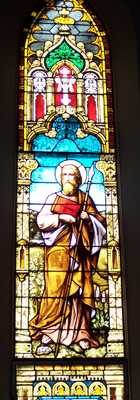
2. The St. Thomas window (photo at right) depicts St. Thomas, one of the twelve apostles, holding a book, a sign of his apostolate. The spear he holds refers to the traditional source of his martyrdom. The background is a slightly defined landscape with patterned etched glass indicating the sky. The pose and size of the saint, as well as the surrounding architectural border, is similar to the flanking St. Patrick and the Blessed Virgin on the north side. Thomas is known as the doubter because at first he refused to believe in the resurrection of Jesus, but he arrived at faith with the words “My Lord and my God.” Tradition says that he traveled as far as India in spreading the gospel. The feast day of St. Thomas is July 3.
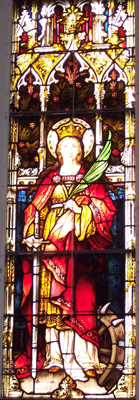
3. The inscription on the St. Catherine of Alexandria window (photo at left) indicates the name of the saint. Catherine’s identity is also revealed by the spiked wheel, symbol of her torture which she miraculously survived, and the sword, symbol of her martyrdom, by which she was beheaded (c. 310). She has a crown to indicate her royal birth and holds the palm of martyrdom. An angel is in the top of the lancet. St. Catherine’s feast day is November 25.
This window, along with four others, was executed by Meyer of Munich and New York. The architectural decoration, predominantly black and white, indicates an intricate High Gothic style. Each of the four has an angel in the top of the lancet within the architectural decoration. In Catherine’s window the angel plays a lute. The oak leaf and acorn figure strongly in the decorative borders. The oak is a symbol of strength and virtue and the endurance of Christianity against adversity.
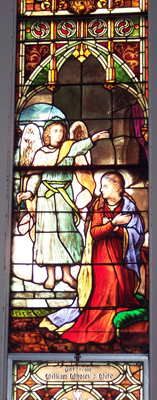
4. One of the three narrative windows, the Annunciation window (photo at right) tells the story of the Archangel Gabriel greeting the Blessed Virgin Mary at the Annunciation of the Incarnation of Our Lord. The window depicts the Virgin at her prie-dieu with an open book, seemingly startled by the angel whom she acknowledges by raising her eyes. The Archangel Gabriel carries his traditional lily, symbol of the purity of the Virgin.
This window is set into a fanciful, ambiguous architectural setting. The style of this window appears to be similar to that of the Presentation in the Temple on the north wall. The Feast of the Annunciation is celebrated on March 25.
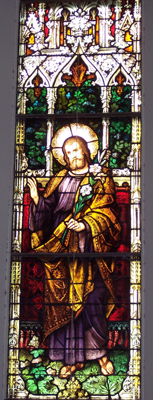
5. In his window (photo at left) St. Joseph, husband of the Blessed Virgin Mary, appears richly dressed in a purple gown and golden brocade (etched glass) cloak. He carries a lily which indicates his rod, which alone of all those of the suitors of the Virgin, miraculously bloomed. The lily also symbolizes his purity. St. Joseph’s feast day is March 19. The St. Joseph window is a Meyer window.
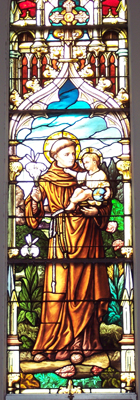
6. The St. Anthony of Padua window (photo at right) shows the thirteenth-century saint tonsured and dressed in his traditional Franciscan habit. He holds the Christ Child in his left arm and a lily in his right. The Christ Child holds a blue orb with a gold band topped with a Latin cross. St. Anthony was a trusted companion of St. Francis, who appreciated the young man’s ability to preach and entrusted to him much of the educational work of the Order. The feast day of St. Anthony of Padua is June 13. The style of this window appears to be unique.
